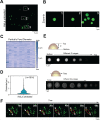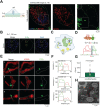Long-term live-cell lipid droplet-targeted biosensor development for nanoscopic tracking of lipid droplet-mitochondria contact sites
- PMID: 34335963
- PMCID: PMC8315056
- DOI: 10.7150/thno.59848
Long-term live-cell lipid droplet-targeted biosensor development for nanoscopic tracking of lipid droplet-mitochondria contact sites
Abstract
Background: Lipid droplets (LDs) establish a considerable number of contact sites with mitochondria to enable energy transfer and communication. In this study, we developed a fluorescent biosensor to image LD-mitochondria interactions at the nanoscale and further explored the function of LD-mediated matrix transmission in processes involving multi-organelle interactions. Methods: A fluorescent probe called C-Py (C21H19N3O2, 7-(diethylamino) coumarin-3-vinyl-4-pyridine acetonitrile) was designed and synthesized. Colocalization of C-Py and the commercial LD stain Nile Red was analyzed in HeLa cells. The fluorescence stability and signal to background ratio of C-Py under structured illumination microscopy (SIM) were compared to those of the commercial probe BODIPY493/503. The cytotoxicity of C-Py was assessed using CCK-8 assays. The uptake pattern of C-Py in HeLa cells was then observed under various temperatures, metabolic levels, and endocytosis levels. Contact sites between LDs and various organelles, such as mitochondria, nuclei, and cell membrane, were imaged and quantitated using SIM. Physical changes to the contact sites between LDs and mitochondria were monitored after lipopolysaccharide induction. Results: A LD-targeted fluorescent biosensor, C-Py, with good specificity, low background signal, excellent photostability, low cytotoxicity, and high cellular permeability was developed for tracking LD contact sites with multiple organelles using SIM. Using C-Py, the subcellular distribution and dynamic processes of LDs in living cells were observed under SIM. The formation of contact sites between LDs and multiple organelles was visualized at a resolution below ~200 nm. The number of LD-mitochondria contact sites formed was decreased by lipopolysaccharide treatment inducing an inflammatory environment. Conclusions: C-Py provides strategies for the design of ultra-highly selective biosensors and a new tool for investigating the role and regulation of LDs in living cells at the nanoscale.
Keywords: contact sites; extended-resolution imaging; lipid droplets; mitochondria.
© The author(s).
Conflict of interest statement
Competing Interests: The authors have declared that no competing interest exists.
Figures





Similar articles
-
Super-resolution dynamic tracking of cellular lipid droplets employing with a photostable deep red fluorogenic probe.Biosens Bioelectron. 2023 Jun 1;229:115243. doi: 10.1016/j.bios.2023.115243. Epub 2023 Mar 21. Biosens Bioelectron. 2023. PMID: 36989580
-
Charge-Dependent Strategy Enables a Single Fluorescent Probe to Study the Interaction Relationship between Mitochondria and Lipid Droplets.ACS Sens. 2021 Apr 23;6(4):1595-1603. doi: 10.1021/acssensors.0c02677. Epub 2021 Mar 23. ACS Sens. 2021. PMID: 33755435
-
A new organic molecular probe as a powerful tool for fluorescence imaging and biological study of lipid droplets.Theranostics. 2023 Jan 1;13(1):95-105. doi: 10.7150/thno.79052. eCollection 2023. Theranostics. 2023. PMID: 36593956 Free PMC article.
-
A different kind of love - lipid droplet contact sites.Biochim Biophys Acta Mol Cell Biol Lipids. 2017 Oct;1862(10 Pt B):1188-1196. doi: 10.1016/j.bbalip.2017.06.005. Epub 2017 Jun 13. Biochim Biophys Acta Mol Cell Biol Lipids. 2017. PMID: 28627434 Review.
-
Perspectives on Mitochondria-ER and Mitochondria-Lipid Droplet Contact in Hepatocytes and Hepatic Lipid Metabolism.Cells. 2021 Sep 1;10(9):2273. doi: 10.3390/cells10092273. Cells. 2021. PMID: 34571924 Free PMC article. Review.
Cited by
-
Facile construction of dual-response super-resolution probes for tracking organelles dynamics.Exploration (Beijing). 2024 Mar 12;4(5):20230145. doi: 10.1002/EXP.20230145. eCollection 2024 Oct. Exploration (Beijing). 2024. PMID: 39439499 Free PMC article.
-
High-throughput assays to assess variant effects on disease.Dis Model Mech. 2024 Jun 1;17(6):dmm050573. doi: 10.1242/dmm.050573. Epub 2024 Jun 28. Dis Model Mech. 2024. PMID: 38940340 Free PMC article.
-
Lysosome-Targeted Biosensor for the Super-Resolution Imaging of Lysosome-Mitochondrion Interaction.Front Pharmacol. 2022 Mar 15;13:865173. doi: 10.3389/fphar.2022.865173. eCollection 2022. Front Pharmacol. 2022. PMID: 35370649 Free PMC article.
-
Super-resolution analyzing spatial organization of lysosomes with an organic fluorescent probe.Exploration (Beijing). 2022 Jun;2(3):20210215. doi: 10.1002/exp.20210215. Epub 2022 Mar 22. Exploration (Beijing). 2022. PMID: 35844970 Free PMC article.
-
In situ visualization of the cellular uptake and sub-cellular distribution of mussel oligosaccharides.J Pharm Anal. 2024 Jun;14(6):100932. doi: 10.1016/j.jpha.2023.12.022. Epub 2024 Jan 4. J Pharm Anal. 2024. PMID: 39021382 Free PMC article.
References
Publication types
MeSH terms
Substances
LinkOut - more resources
Full Text Sources
Research Materials

